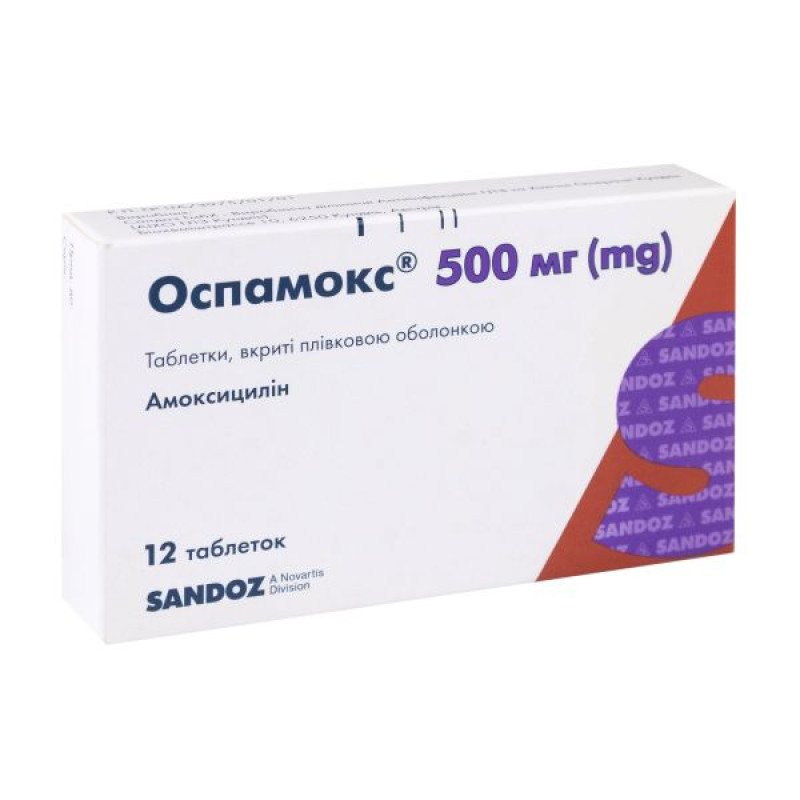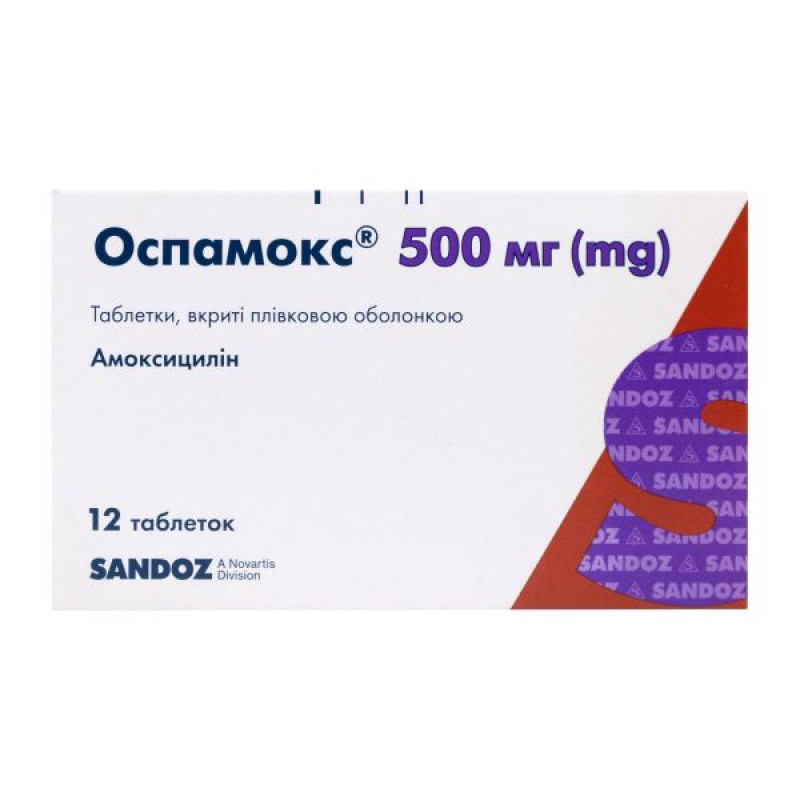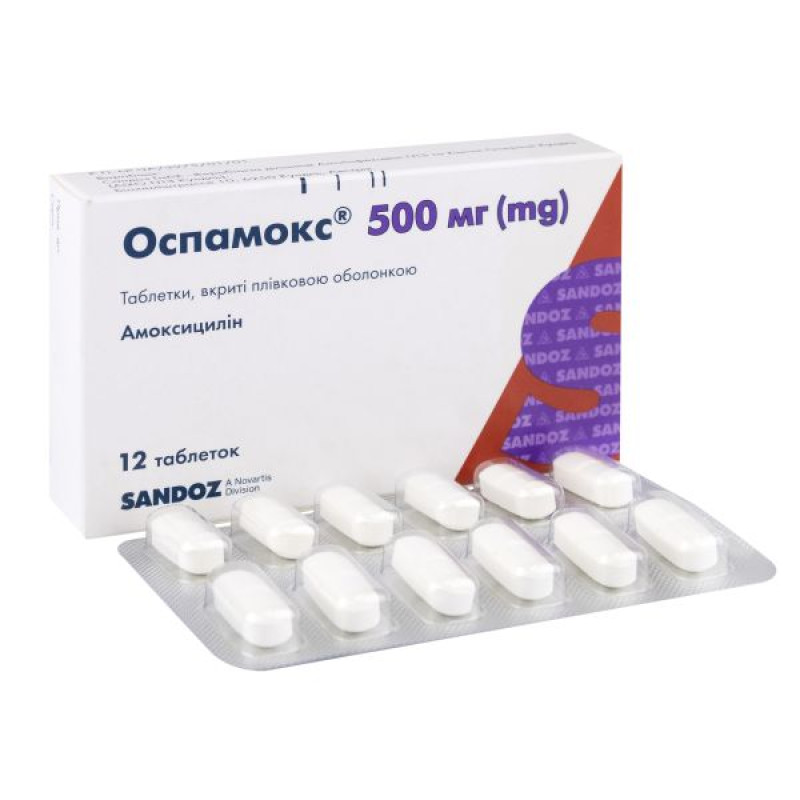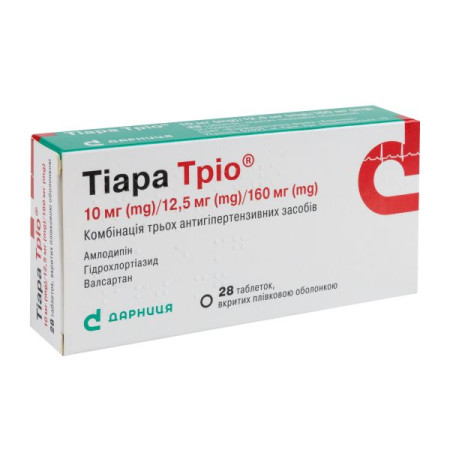Ospamox film-coated tablets 500 mg No. 12

Instructions for Ospamox film-coated tablets 500 mg No. 12
Composition
active ingredient: amoxicillin;
1 tablet contains 500 mg or 1000 mg of amoxicillin in the form of amoxicillin trihydrate;
excipients: magnesium stearate, aspartame (E 951), croscarmellose sodium, mannitol (E 421), talc, colloidal anhydrous silicon dioxide, microcrystalline cellulose, maltodextrin, pregelatinized pea hydroxypropyl starch, titanium dioxide (E 171), peach-apricot flavoring powder, orange flavoring powder.
Dosage form
Dispersible tablets.
Main physicochemical properties: oblong biconvex tablets from white to yellowish-white color, with a score on both sides of the tablet.
Pharmacotherapeutic group
Antimicrobials for systemic use. Beta-lactam antibiotics. Broad-spectrum penicillins. Amoxicillin. ATX code J01C A04.
Pharmacological properties
Mechanism of action
Amoxicillin is a semisynthetic penicillin (beta-lactam antibiotic) that inhibits one or more enzymes [namely, penicillin-binding proteins (PBPs)] in the biosynthetic metabolism of bacterial peptidoglycan, which is an integral structural component of the bacterial cell wall. Inhibition of peptidoglycan synthesis leads to weakening of the cell wall, resulting in cell lysis and death. Amoxicillin is inactive against microorganisms that produce beta-lactamases.
Pharmacokinetics/pharmacodynamics relationship
The time it takes for the antibiotic concentration to reach the minimum inhibitory concentration (T > MIC) is a very important factor for the successful treatment of bacterial infections with amoxicillin.
Resistance mechanisms
The main mechanisms of resistance to amoxicillin are:
- inactivation by bacterial beta-lactamases;
- conversion of PZB, which reduces the affinity of the antibacterial drug with the target structures.
Bacterial impermeability or efflux pump mechanisms can cause or contribute to bacterial resistance, particularly in Gram-negative bacteria.
Limit values
MIC breakpoints for amoxicillin established by the European Committee on Antimicrobial Susceptibility Testing (EUCAST), version 5.0
| Microorganisms | MIC limit values (mg/l) | |
| Sensitive ≤ | Resistant ≥ | |
| Enterobacteriaceae | 81 | 8 |
| Staphylococcus spp. | Note2 | Note2 |
| Enterococcus spp.3 | 4 | 8 |
| Streptococci of groups A, B, C and G | Note4 | Note4 |
| Streptococcus pneumoniae | Note5 | Note5 |
| Viridans group streptococci | 0.5 | 2 |
| Haemophilus influenzae | 26 | 26 |
| Moraxella catarrhalis | Note7 | Note7 |
| Neisseria meningitidis | 0.125 | 1 |
| Gram-positive anaerobic bacteria, except Clostridium difficile8 | 4 | 8 |
| Gram-negative anaerobic bacteria8 | 0.5 | 2 |
| Helicobacter pylori | 0.1259 | 0.1259 |
| Pasteurella multocida | 1 | 1 |
| Limit values not specific to specific species10 | 2 | 8 |
1 Wild-type Enterobacteriaceae are considered susceptible to aminopenicillins. Some countries prefer to classify wild-type isolates of E. coli and P. mirabilis as intermediate. When this is the case, a MIC S cut-off value of ≤0.5 mg/L is used. 2 Most staphylococci produce penicillinase. They are resistant to amoxicillin. Methicillin-resistant isolates are, with some exceptions, resistant to all beta-lactam agents. 3 Susceptibility to amoxicillin can be inferred from susceptibility to ampicillin. 4 The susceptibility of streptococci of groups A, B, C and G to penicillins can be inferred from their susceptibility to benzylpenicillin. 5 Breakpoints apply only to non-meningitic isolates. For isolates with intermediate susceptibility to ampicillins, oral amoxicillin should be avoided. Susceptibility can be inferred from the ampicillin MIC. 6 Breakpoints are established for intravenous administration. It should be noted that beta-lactamase-positive isolates are resistant. 7 It should be noted that organisms that produce beta-lactamase are resistant. 8 Susceptibility to amoxicillin can be inferred from susceptibility to benzylpenicillin. 9 Breakpoints are based on epidemiological cut-off points (ECOFFs) that separate wild-type isolates from isolates with reduced susceptibility. 10 Non-species specific limit values are calculated based on dosages of at least 0.5 g × 3 or 4 doses once daily (1.5–2 g/day). | ||
The level of resistance of susceptible microorganisms may vary depending on the region.
Susceptibility of microorganisms to amoxicillin in vitro
The following types of microorganisms are sensitive to the drug:
Gram-positive aerobes: Enterococcus faecalis, beta-hemolytic streptococci (groups A, B, C, G) – Listeria monocytogenes.
Intermittently sensitive (acquired resistance may be a problem):
Gram-positive aerobes: coagulase-negative staphylococci: Staphylococcus aureus1, Streptococcus pneumoniae; Viridans group of streptococcal bacteria.
1Almost all S. aureus are resistant to amoxicillin due to the production of penicillinase. In addition, all methicillin-resistant strains are resistant to amoxicillin.
Gram-positive anaerobes: Clostridium spp.
Gram-negative anaerobes: Fusobacterium spp.
Other microorganisms: Borrelia burgdorferi.
Microorganisms that have natural resistance to antibiotics2:
Gram-positive aerobes: Enterococcus faecium2.
2 Natural intermediate susceptibility in the absence of an acquired resistance mechanism.
Gram-negative aerobes: Acinetobacter spp., Enterobacter spp., Klebsiella spp., Pseudomonas spp.
Gram-negative anaerobes: Bacteroides spp. (some strains of Bacteroides fragilis are resistant).
Other microorganisms: Chlamydia spp., Mycoplasma spp., Legionella spp.
Pharmacokinetics.
Absorption. Amoxicillin is completely soluble in aqueous solution at physiological pH. It is rapidly and well absorbed after oral administration. The bioavailability of amoxicillin after oral administration is approximately 70%. The maximum concentration of the active substance in the blood plasma is reached after approximately 1 hour.
The results of pharmacokinetic studies in which amoxicillin 250 mg three times daily was administered in the fasted state in a group of healthy volunteers are presented below.
Cmax (μg/ml) | Tmax* (d) | AUC(0–24h) (μg×g/ml) | T½ (d) |
| 3.3 ± 1.12 | 1.5 (1.0–2.0) | 26.7 ± 4.56 | 1.36 ± 0.56 |
| *Average value (range) | |||
When using doses from 250 to 3000 mg, bioavailability (AUC and Cmax parameters) is linearly proportional to the dose. Simultaneous food intake does not affect absorption.
Hemodialysis can be used to remove amoxicillin.
Distribution. Approximately 18% of amoxicillin is bound to plasma proteins, with an apparent volume of distribution of about 0.3–0.4 l/kg. After intravenous administration, amoxicillin has been found in the gallbladder, abdominal tissue, skin, adipose tissue, muscle tissue, synovial and peritoneal fluids, bile, and pus. Amoxicillin penetrates poorly into the cerebrospinal fluid. Animal studies have shown no evidence of significant retention of substances derived from any component of the drug in body tissues.
Amoxicillin, like most penicillins, can pass into breast milk. Amoxicillin has been shown to cross the placental barrier.
Biotransformation: Amoxicillin is partially excreted in the urine as inactive penicillic acid in amounts equivalent to 10–25% of the initial dose.
Excretion. Amoxicillin is excreted primarily by the kidneys. In healthy volunteers, the mean elimination half-life of amoxicillin is approximately one hour and the mean total clearance is approximately 25 l/h. Approximately 60–70% of the dose administered is excreted unchanged in the urine within the first 6 hours after a single dose of 250 mg or 500 mg of amoxicillin. Various studies have shown that urinary excretion of amoxicillin is 50–85% over a 24-hour period. Concomitant use of probenecid slows the elimination of amoxicillin.
Age. The elimination half-life of amoxicillin is identical in children aged 3 months to 2 years, older children and adults. For children (including premature infants) in the first week of life, the frequency of administration should not exceed twice daily due to the immaturity of the renal excretion pathway. Since elderly patients are more prone to decreased renal function, dosage should be selected with caution, and monitoring of renal function is also recommended.
Gender: Following oral administration of amoxicillin to healthy male and female subjects, there was no significant effect of gender on the pharmacokinetics of amoxicillin.
Renal impairment: Total serum clearance of amoxicillin decreases proportionally with decreasing renal function.
Hepatic impairment: Patients with hepatic impairment should take the drug with caution. Liver function should be monitored regularly.
Indication
Amoxicillin is indicated for the treatment of the following infections:
– acute bacterial sinusitis;
– acute otitis media;
– acute streptococcal tonsillitis and pharyngitis;
– exacerbation of chronic bronchitis;
– community-acquired pneumonia;
– acute cystitis;
– asymptomatic bacteriuria during pregnancy;
– acute pyelonephritis;
– typhoid and paratyphoid fever;
– dental abscesses with widespread cellulitis;
– infections of prosthetic joints;
– eradication of Helicobacter pylori (as part of combination therapy);
– Lyme disease.
The drug is used for the treatment and prevention of endocarditis.
Contraindication
Hypersensitivity to amoxicillin, other penicillins or excipients of the drug. History of severe hypersensitivity reactions (including anaphylaxis) to beta-lactam antibiotics (including cephalosporins, carbapenems or monobactams).
Interaction with other medicinal products and other types of interactions
Allopurinol. Concomitant use with amoxicillin increases the likelihood of allergic skin reactions.
Tetracyclines. Tetracyclines and other drugs that have a bacteriostatic effect (macrolides, chloramphenicol) can neutralize the bactericidal effect of amoxicillin.
Parallel use of aminoglycosides is possible (synergistic effect).
Oral anticoagulants. Oral anticoagulants and penicillin antibiotics are widely used in practice; no interactions have been reported. However, isolated cases of increased international normalized ratio (INR) have been described in patients receiving amoxicillin and acenocoumarol or warfarin concomitantly. If such use is necessary, prothrombin time or INR should be closely monitored. In addition, dose adjustment of oral anticoagulants may be necessary.
Methotrexate. The use of amoxicillin with methotrexate leads to an increase in the toxic effect of the latter. Amoxicillin reduces the renal clearance of methotrexate, so its serum concentration should be checked.
Digoxin. The absorption of digoxin increases, so its dose should be adjusted.
Amoxicillin should be used with caution in combination with oral hormonal contraceptives, as plasma levels of estrogen and progesterone may be temporarily decreased, which may reduce the effectiveness of hormonal contraceptives. Therefore, the use of additional non-hormonal contraceptives is recommended.
Other types of interactions.
Forced diuresis leads to a decrease in the concentration of amoxicillin in the blood plasma due to an increase in its elimination.
The occurrence of diarrhea may lead to a decrease in the absorption of other drugs and adversely affect their effectiveness.
Elevated levels of amoxicillin in blood plasma and urine may interfere with the results of some laboratory tests. False-positive results are commonly observed with chemical methods.
When determining glucose in urine, it is recommended to use the enzymatic glucose oxidase method.
The presence of amoxicillin may affect the results of estriol quantification in pregnant women.
At high concentrations, amoxicillin may reduce serum glycemia. Amoxicillin may interfere with colorimetric protein determination.
Application features
Hypersensitivity.
Before initiating treatment with amoxicillin, it is necessary to accurately determine the presence of a history of hypersensitivity reactions to penicillins, cephalosporins or other allergens.
Serious and sometimes fatal cases of hypersensitivity (anaphylactoid reactions and severe cutaneous adverse reactions) have been reported in patients receiving penicillin therapy. Such reactions are more likely to occur in patients with a history of hypersensitivity to penicillins or in patients with hypersensitivity to various allergens. If an allergic reaction occurs, amoxicillin therapy should be discontinued and appropriate treatment should be initiated.
Acute coronary syndrome associated with hypersensitivity reaction (Kounis syndrome)
Hypersensitivity reactions (acute coronary syndrome associated with hypersensitivity reactions, see section 4.8) have been reported rarely with amoxicillin; appropriate treatment should be given if such reactions occur.
Non-susceptible organisms: Since amoxicillin is not indicated for the treatment of certain types of infections, the drug should be used only when the pathogenic microorganism is identified or when there is reason to believe that the infectious agent is likely to be susceptible to amoxicillin (see section 5.1). This is particularly true in patients with genitourinary tract infections and severe ear, nose and throat infections.
Convulsions: Convulsions may occur in patients with impaired renal function, as well as in those receiving high doses of the drug or with a predisposition to seizures (e.g., history of epileptic seizures, treated epilepsy, meningitis) (see section "Adverse reactions").
Renal impairment: In patients with renal impairment, the dose of amoxicillin should be adjusted depending on the degree of renal impairment.
Skin reactions
The appearance of generalized erythema with fever associated with pustules at the beginning of treatment may be a symptom of acute generalized exanthematous pustulosis. In such cases, treatment should be discontinued and further use of amoxicillin is contraindicated.
Amoxicillin can cause severe skin reactions such as toxic epidermal necrolysis, Stevens-Johnson syndrome, and drug reaction with eosinophilia and systemic symptoms (DRESS). If severe skin reactions occur, amoxicillin should be discontinued and appropriate treatment and/or measures should be taken.
Infectious mononucleosis.
Patients with infectious mononucleosis or lymphoid leukemoid reactions have frequently (60–100%) developed a rash that is not due to penicillin hypersensitivity. Therefore, ampicillin-class antibiotics should not be used in patients with mononucleosis.
Jarisch-Herxheimer reaction. During the treatment of Lyme disease, a Jarisch-Herxheimer reaction may occur (see the section "Adverse reactions"), which occurs as a result of the bactericidal effect of amoxicillin on the causative agent of Lyme disease, the spirochete Borrelia burgdorferi.
Cross-resistance. Cross-hypersensitivity and cross-resistance may exist between penicillins and cephalosporins.
Resistance: Prolonged use of the drug may sometimes cause overgrowth of insensitive microflora. As with other broad-spectrum penicillins, superinfections may occur.
Antibiotic-associated colitis, ranging from mild to life-threatening, has been reported with the use of nearly all antibacterial agents, including amoxicillin. If severe diarrhea consistent with pseudomembranous colitis (mostly caused by Clostridium difficile) occurs, discontinuation of the drug and appropriate supportive measures should be considered. Antiperistaltic agents are contraindicated. Appropriate supportive measures should also be taken in the event of hemorrhagic colitis or hypersensitivity reactions.
Patients with severe gastrointestinal disorders accompanied by diarrhea and vomiting should not use the drug due to the risk of reduced absorption.
Long-term therapy: During long-term treatment, it is recommended to periodically evaluate the functions of body systems, including the urinary, hepatobiliary and hematopoietic systems. Elevated liver enzymes and changes in blood counts have been reported.
Anticoagulants: Prolongation of prothrombin time has been reported very rarely in patients receiving amoxicillin. When co-administered with anticoagulants, appropriate monitoring should be carried out and the dose of the latter adjusted if necessary.
Crystalluria. Crystalluria has been observed very rarely in patients with reduced diuresis, mainly with parenteral therapy. When using high doses of the drug, it is necessary to drink sufficient fluids to prevent amoxicillin-associated crystalluria. The presence of high concentrations of amoxicillin in the urine may cause precipitation in the urinary catheter, so it should be visually inspected at regular intervals.
In premature infants and in the neonatal period, kidney, liver, and blood function should be monitored.
When using amoxicillin as part of combination therapy for the eradication of Helicobacter pylori, the instructions for medical use of other medicines for combination therapy should be consulted.
Ospamox DT should be used with extreme caution in patients with phenylketonuria, as the medicine contains aspartame (E 951).
Impact on diagnostic test results
Increased serum and urine levels of amoxicillin may interfere with the results of some laboratory tests. Due to the high concentration of amoxicillin in urine, chemical methods often give false-positive results.
When determining glucose in urine during treatment with amoxicillin, it is recommended to use enzymatic glucose oxidase methods.
The presence of amoxicillin may affect the results of estriol quantification in pregnant women.
Use during pregnancy or breastfeeding
Amoxicillin crosses the placental barrier; its concentration in the fetal plasma is approximately 25-30% of the concentration in the pregnant woman's plasma. Limited data on the use of amoxicillin during pregnancy indicate the absence of undesirable effects on the fetus/newborn. Animal studies have shown the absence of teratogenic effects of amoxicillin. If it is necessary to prescribe amoxicillin during pregnancy, a careful assessment of the ratio of the potential risk to the fetus and the expected benefit to the woman should be carried out.
Amoxicillin is excreted in small amounts in breast milk, so the risk of hypersensitivity in the child during breastfeeding cannot be excluded. The use of the drug during this period is possible only if the expected benefit to the woman outweighs the potential risk to the child. Breastfeeding should be discontinued if the newborn develops gastrointestinal disorders (diarrhea), candidiasis or skin rash.
Fertility: There are no data on the effects of amoxicillin on fertility in humans. Animal reproductive toxicity studies have shown no effect on fertility.
Ability to influence reaction speed when driving vehicles or other mechanisms
Studies on the effects on the ability to drive and use machines have not been conducted. However, some adverse reactions (e.g. allergic reactions, dizziness, convulsions) may affect the ability to drive or use machines.
Method of administration and doses
The dose of amoxicillin is determined by the doctor depending on the age, body weight and kidney condition of the patient, as well as the sensitivity of microorganisms and the localization of the infectious process.
Adults and children weighing ≥ 40 kg Table 1
| Indication* | Dose* |
| Acute bacterial sinusitis | 250 mg to 500 mg every 8 hours or 750 mg to 1000 mg every 12 hours In case of severe infections – 750 mg to 1000 mg every 8 hours For acute cystitis, 3000 mg twice daily for 1 day may be prescribed. |
| Asymptomatic bacteriuria during pregnancy | |
| Acute pyelonephritis | |
| Dental abscesses with widespread cellulitis | |
| Acute cystitis | |
| Acute otitis media | 500 mg every 8 hours or 750 mg to 1000 mg every 12 hours In case of severe infections – 750 mg to 1000 mg every 8 hours for 10 days |
| Acute streptococcal tonsillitis and pharyngitis | |
| Exacerbation of chronic bronchitis | |
| Community-acquired pneumonia | 500 mg to 1000 mg every 8 hours |
| Typhoid and paratyphoid fever | 500 mg to 2000 mg every 8 hours |
| Infections of prosthetic joints | 500 mg to 1000 mg every 8 hours |
| Prevention of endocarditis | 2000 mg orally, single dose 30–60 minutes before procedure |
Helicobacter pylori eradication (as part of combination therapy) | 750 mg to 1000 mg twice daily in combination with a proton pump inhibitor (e.g., omeprazole, lansoprazole) and another antibiotic (e.g., clarithromycin, metronidazole) for 7 days |
| Lyme disease | Initial stage – from 500 mg to 1000 mg every 8 hours, maximum dose – 4000 mg/day in several doses for 14 days (the course of treatment can last from 10 to 21 days) Late stage (systemic lesions) – from 500 mg to 2000 mg every 8 hours, maximum dose – 6000 mg/day in several doses for 10–30 days |
| * Official guidelines for appropriate treatment for each indication should be considered. | |
Children weighing < 40 kg
Children can take amoxicillin in the form of an oral suspension prepared from Ospamox oral suspension powder or Ospamox DT dispersible tablets, provided that treatment regimens using the appropriate dosage forms are provided. Amoxicillin in the form of a suspension is prescribed to children under 6 months of age. Children weighing more than 40 kg should be given adult doses.
Table 2
| Indication* | Dose* |
| Acute bacterial sinusitis | 20 to 90 mg/kg/day in divided doses** (do not exceed 3 g/day) |
| Acute otitis media | |
| Community-acquired pneumonia | |
| Acute sinusitis | |
| Acute pyelonephritis | |
| Dental abscesses with widespread cellulitis | |
| Acute streptococcal tonsillitis and pharyngitis | 40 to 90 mg/kg/day in divided doses** (do not exceed dose of 3 g/day) |
| Typhoid and paratyphoid fever | 100 mg/kg/day in three divided doses |
| Prevention of endocarditis | 50 mg/kg orally, single dose 30–60 minutes before procedure |
| Lyme disease | Initial stage – 25 to 50 mg/kg/day in three divided doses for 10–21 days Late stage (systemic lesions) – 100 mg/kg/day in three divided doses for 10–30 days |
*Official guidelines for appropriate treatment for each indication should be considered. ** It is recommended to divide the daily dose of the drug into 2 doses if it is close to the maximum recommended dose. | |
Elderly patients (65 years and older)
There is no need to adjust the dose of the drug.
Patients with renal impairment.
Table 3
| Creatinine clearance, ml/min | Adults and children, body weight ≥ 40 kg | Children, body weight < 40 kg# |
| > 30 | Does not require dose adjustment | Does not require dose adjustment |
| 10–30 | Maximum 500 mg 2 times a day | 15 mg/kg 2 times a day (maximum 500 mg 2 times a day) |
| < 10 | Maximum 500 mg per day | 15 mg/kg once daily (maximum 500 mg per day) |
# In most cases, parenteral therapy is preferred.
Patients on hemodialysis
Amoxicillin can be removed from the body by hemodialysis.
Table 4
| Hemodialysis | |
| Adults, children and adolescents weighing > 40 kg | 15 mg/kg/day as a single daily dose. One additional dose of 15 mg/kg should be administered prior to hemodialysis. Another dose of 15 mg/kg should be administered after hemodialysis to restore circulating levels of active substance. |
Maximum 500 mg of amoxicillin per day.
Patients with impaired liver function. In case of impaired liver function, the drug should be used with caution, regularly monitoring liver function.
Duration of use: In case of mild to moderate infections, the drug should be taken for 5–7 days. However, if the infections are caused by streptococcus, the duration of treatment should be at least 10 days.
In the case of chronic diseases, local infectious lesions, and severe infections, the duration of treatment is determined by the clinical picture.
Method of administration: Food intake does not affect the absorption of amoxicillin. Amoxicillin therapy can be initiated parenterally according to the dosing recommendations for intravenous drugs and continued by oral administration.
The tablets can be taken in two different ways: they can be swallowed whole with water, or the tablet can be dissolved in water. The tablets can be divided to make swallowing easier.
Children
Used in pediatric practice (see section "Method of administration and dosage").
Overdose
Symptoms: digestive tract dysfunction – nausea, vomiting, diarrhea, which may result in a violation of water and electrolyte balance.
Cases of crystalluria, sometimes leading to renal failure, have been reported.
Convulsions may occur in patients with impaired renal function or those who have received high doses of amoxicillin (see sections "Special warnings and precautions for use" and "Adverse reactions").
Treatment: induce vomiting or gastric lavage, followed by administration of activated charcoal and an osmotic laxative. Maintain fluid and electrolyte balance. Amoxicillin can be removed from the bloodstream by hemodialysis. No specific antidote is known.
Adverse reactions
The most common adverse reactions are diarrhea, nausea, and skin rashes.
Criteria for assessing the frequency of adverse reactions: common (≥ 1/100, < 1/10), uncommon (≥ 1/1000, < 1/100), rare (≥ 1/10,000, < 1/1000), frequency unknown (frequency cannot be estimated due to lack of data).
Infections and infestations: rare - prolonged or repeated use of the drug may lead to the development of superinfections and overgrowth of non-susceptible microorganisms or yeasts, causing candidiasis of the skin and mucous membranes.
From the blood and lymphatic system: rare - eosinophilia, hemolytic anemia; rare - leukopenia, severe neutropenia, agranulocytosis, thrombocytopenia, pancytopenia, myelosuppression, granulocytopenia, increased bleeding time and prothrombin index. These manifestations are reversible upon discontinuation of treatment.
On the part of the immune system: rare - severe allergic reactions, including angioedema (Quincke's edema), anaphylaxis, serum sickness, allergic vasculitis, laryngeal edema, anaphylactic shock; frequency unknown - Jarisch-Herxheimer reaction.
On the part of the digestive tract: frequent - diarrhea, nausea, vomiting, flatulence, stomach pain, soft stools, itching in the anus, loss of appetite, enanthema (especially in the mouth), dry mouth, taste disturbance; rare - discoloration of the surface of the teeth (especially in children when taking the suspension). Proper oral hygiene procedures can prevent tooth discoloration, since such plaque is mostly removed when brushing the teeth; rare - antibiotic-associated colitis (including pseudomembranous and hemorrhagic colitis), intestinal candidiasis, black tongue color. These side effects are mostly not serious and disappear either during treatment or immediately after the end of therapy. The occurrence of such effects can be prevented if amoxicillin is taken with food.
Nervous system: rare - hyperkinesia, hyperactivity, dizziness, convulsions (in patients with epilepsy and meningitis, in case of impaired renal function, when using high doses of amoxicillin), aseptic meningitis.
From the hepatobiliary system: rare - hepatitis, cholestatic jaundice, moderate and short-term increase in liver enzymes (AST, ALT).
Skin and subcutaneous tissue disorders: common: skin rash, urticaria, pruritus; rare: erythema multiforme, Stevens-Johnson syndrome, toxic epidermal necrolysis, bullous and exfoliative dermatitis, acute generalized exanthematous pustulosis, Lyell's syndrome, drug reaction with eosinophilia and systemic symptoms (DRESS syndrome).
The sudden onset of urticaria indicates an allergic reaction to amoxicillin and requires immediate discontinuation of therapy.
From the kidneys and urinary system: rare - acute interstitial nephritis, crystalluria.
Others: isolated - fever.
Expiration date
3 years.
Storage conditions
Store at a temperature not exceeding 30 °C in the original packaging.
Keep out of reach of children.
Packaging
500 mg tablets: 10 or 12 tablets in a blister; 2 (10 ´ 2) or 1 (12 ´ 1) blisters in a cardboard box;
1000 mg tablets: 6 or 10 tablets in a blister; 2 (6 ´ 2 or 10 ´ 2) blisters in a cardboard box.
Vacation category
According to the recipe.
Producer
Sandoz GmbH - Production site Anti-infectives and Chemical Operations Kundl (AIHO Kundl).
Location of the manufacturer and address of its place of business
Biochemiststrasse 10, 6250 Kundl, Austria.
There are no reviews for this product.
There are no reviews for this product, be the first to leave your review.
No questions about this product, be the first and ask your question.










